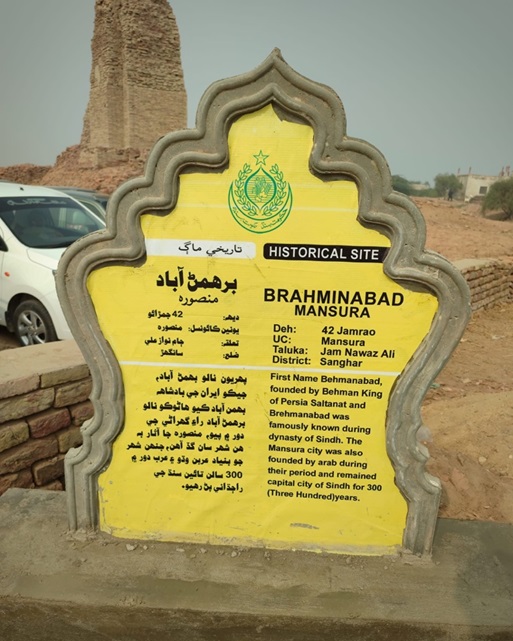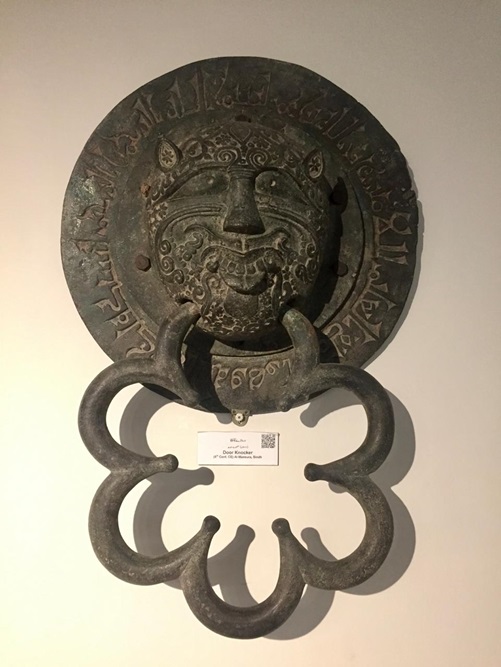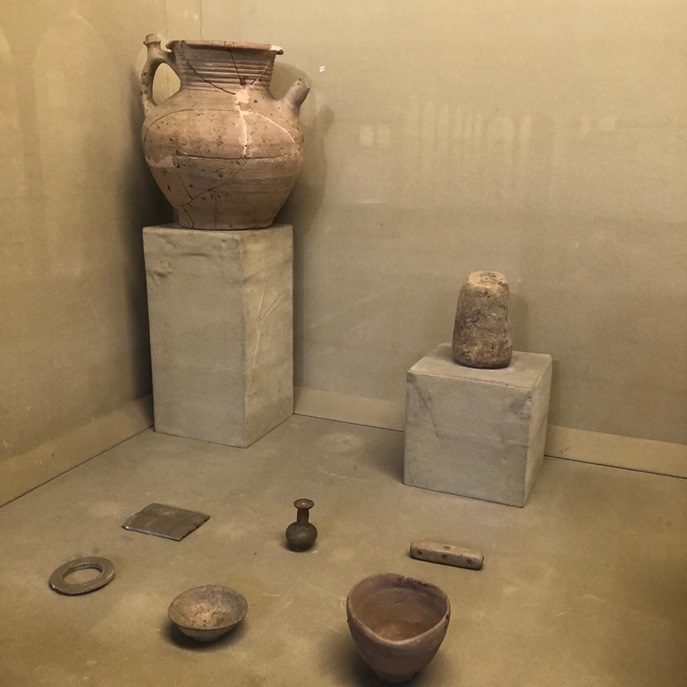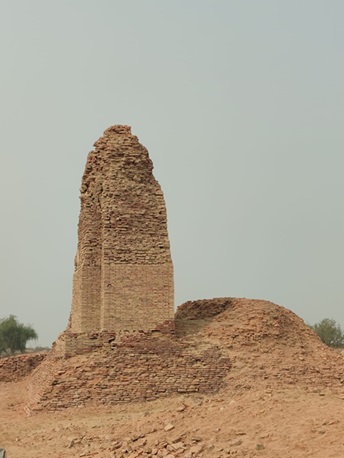
Written by: Sirat Gohar Daudpoto
Posted on: February 23, 2024 |  | 中文
| 中文
Al Mansura (Brahamanabad)
In Pakistan, a number of ancient of sites have been discovered as the result archaeological explorations in different parts of the country. In the inventory of ancient sites of Pakistan, some cities of the bygone civilizations are also inscribed. And these cities date to different phases of ancient period, which is the longest period of the history of Pakistan, starting from the stone age (2.5 million years before present) to the arrival of Muslims (early 8th century CE). The ancient cities of Pakistan are famous all over the world. The most famous amongst these are Mohenjodaro, Harappa, Taxila, Barikot, Aror, Bhanbhore and Al-Mansura. This article is about the ancient city of Al-Mansura, more specifically on the archaeology and history of its foundation.

Signboard at the ancient city of Al-Mansura in Sindh (Photograph taken by Prof. Dr. Intesab Hussain Sadhayo)
The ancient city of Al-Mansura, also known as Mansura, is situated about eighteen kilometers away from Shahdadpur town in Sanghar District of the Sindh province of Pakistan. According to the information provided on the website of the Directorate General of Antiquities and Archaeology, Culture, Tourism, Antiquities and Archives Department, Government of Sindh, the archaeological site of Al-Mansura is “spread over an areas 6.4 km in circumference near the modern city of Shahdadpur”, and is “usually known as Brahmanabad, and locally as Dalu Raja-ji-Nagri in Sindh”. On the website of the Directorate General of Antiquities and Archaeology, the names Brahmanabad and Mansura are used interchangeably for the site. About the local nomenclature of the site, H.T. Lambrick writes in his book titled “Sindh: A General Introduction”, that the site “is to this day called locally “Brahmanabad” or “Bhambhra-jo-Thul”. He further writes, “it is natural to assume a priori that Mansurah was built actually on the site of the older city”.
Founded during the Umayyad rule in Sindh, according to Ahmad Nabi Khan, historical accounts are provided in, “al-Baladhuri, al-Mas’udi, al-Istakhri, Ibn Hauqal, al-Maqdasi, Buzurg ibn Shahriyar, Ibn Hazm, al-Idrisi, Yaqut al-Hamvi, Qazwini, Ibn Asir, al-Beruni, Ibn Khalladun, Ibn Wardi and others”. The following quote from S. Jabir Raza’s article titled, “Mansurah: A city in the age of urban decline”, informs how the city got its name: Al-Mansura or Mansura.
Several Arab geographers believed that the city derived it[s] name from the last Umayyad governor of Sind, Jamhur al-Kalbi. Among the Arab geographers, there was also the view that Mansurah received its name after the second Abbasid Caliph, Abu Jafar al-Mansur, and for one Arab geographer at least, it was styled, Mansuriya thani, that is the second Mansurah. Interestingly, Al-Biruni has a different take on the matter, and argues that the name of the city was not coined after any caliph or governor, but was adopted by its founder, to signify ‘victory’. The word Mansurah is, derived from the root word, nasr, meaning ‘victory’. He is supported by Abul Fida, who informs us that numerous cities were named during the period as Mansurah, signifying victory and success.

Door Knocker discovered from the ancient city of Al-Mansura, on display in Islamabad Museum (Photograph taken by the author).
Similarly, there are conflicting opinions about the founder of this city. S. Jabir Raza writes that “Al-Idrisi and Ibn al-Wardi inform us that the founder of Mansurah was the second Abbasid caliph, Abu Jaafar al Mansur. Yaqut, on the other hand, is of the opinion that the city was founded by Amir ibn Hafs al-Hazarmard al-Muhallabi. In the opinion of al-Masudi, however, the real founder of Mansura was Mansur ibn Jamhur al-Kalbi. Baladuri tells us that the city was founded by Amr, son of Muhammad bin Qasim, during the governorship of Hakam ibn Awanah al-Kalbi in the reign of the Umayyad caliph Hisham ibn abd al-Malik. Baladuri is supported, amongst others, by Yaqubi, Ibn Khaldun and Ibn al-Athir. Among most of the modern scholars, Baladuri’s evidence is treated as the most reliable. For example, Ahmad Nabi Khan in his book on Al-Mansurah, and Abdul Aziz Farooq in his excavation report titled “Excavations at Mansurah”, referring to al-Baladhuri write, that the city was founded by Amar (Amr) Bin Muhammad Bin Qasim. Ahmad Nabi Khan places the date of the foundation of the city between 728 CE and 737 CE.

Early Islamic period (8th century CE) pottery from the ancient city of Bhanbhore in Sindh on display in Lahore Museum (Photograph taken by the author)
There is a popular view that the city of Al-Mansura was built on the remains of the city of Brahmanabad by Muslim rulers. They destroyed the existing city and built their capital, Al-Mansura on it. However, the archaeological evidence proves that Al-Mansura was built on a vacant land that prior to Al-Mansura’s construction, was not in use for decades or probably for centuries. Archaeologically speaking, twenty-five layers have been excavated at the site. Abdul Aziz Farooq in his excavation report writes: “The layers (1 to 10), represent the period of Muslim occupation, based on the study of pottery found on the site, has yielded four distinct building phases. The layers (11 to 17), consist of river silt and sand, but the layer (18) contained cultural material of a pre-Muslim settlement. Again layers (19 to 25) comprised a thick sandy deposit. The pre-Muslim occupation indicates no connection with the Muslim era as the river deposit, about 15 inches in thickness, separated the two main occupations, viz. Pre-Muslim and Muslim”.

Structural remains at the ancient city of Al-Mansura (Photograph taken by Prof. Dr. Intesab Hussain Sadhayo).
Overall, the archaeological excavations carried out at the site brought to fore that the ancient city of Al-Mansura was not constructed on top of the existing city of Brahmanbad. In fact, archaeological evidence suggests that it was founded on a vacant piece of land covered with river silt and sand by Muslim rulers in the early 8th century CE.

Early Islamic period (8th century CE) glazed pottery (bowl) from the ancient city of Bhanbhore in Sindh on display in Lahore Museum (Photograph taken by the author)
You may also like: